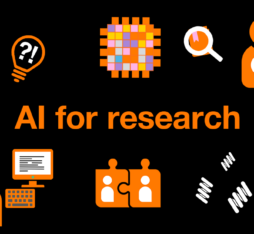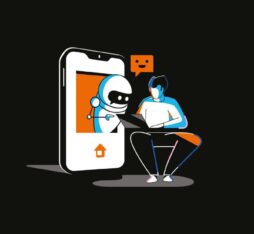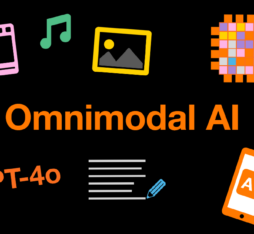For example, it is used in some call centers to recognize a person’s emotional state through their intonation.
AI can be defined as a blend of science and technology that attempts to use machines to replicate human-specific cognitive skills, such as the ability to see, sense, hear, listen, speak, understand natural language, reason, learn and, finally, feel emotion.
AI is only just at the start of its development and is continuing to progress quickly. However, it still has a long way to go before it reaches human-level intelligence.
It is used to help, support, assist and lighten the load of human intelligence, rather than replace it.
Jérôme Colombain: Today, we’re going to talk about Artificial Intelligence with Fayçal Boujemaa. Hello.
Fayçal Boujemaa: Yes, hello.
JC: You’re a Technology Strategist from the Data and Artificial Intelligence Department at Orange. We know AI is currently everywhere, but we need to have a better understanding of it. If you don’t mind, Fayçal Boujemaa, let’s go back to basics. What exactly is Artificial Intelligence?
FB: Artificial Intelligence can be defined as an attempt to get machines to replicate human-specific cognitive skills. We, as human beings, are well aware of these skills, such as the ability to see, sense, hear, listen, speak, understand natural language, reason, learn—that’s particularly important—and to feel emotion. In fact, Artificial Intelligence is a blend of science and technology that attempts to replicate these innate abilities that we all possess.
One of the AI pillars is computer vision. For speaking or listening, we have everything related to speech recognition or synthesis. For learning, we have the famous Machine Learning or Deep Learning.
But there is actually a significant, more recent Artificial Intelligence pillar that attempts to interpret emotions. For example, by reading a human face through its creases and by looking at body language, interpreting a person’s gestures, head movements, arm movements and so on. And then there’s the synthesis of emotions. For example, humanoid robots that can also synthesize emotions.
JC: AI is an old discipline that dates back to the 1950s. And we know that behind it all is mathematics. But it’s still quite a long way from human intelligence — that is, intelligence as we usually understand it. Is it not?
FB: AI is relatively old, but actually, I think in the 1950s, 60s or even 70s, we lacked the computing power, as well as the data. In fact, the resurgence of AI, even if the foundations date back to the 1950s, can be explained by the fact that we have much more data for a machine to learn. It’s also our computing ability, which has evolved a lot since the 1960s and 70s. And finally, there’s the intrinsic progress linked to the discipline itself: the learning techniques, particularly Deep Learning. This too has allowed AI to make a great leap forward since around the 2010s.
We are only right at the very beginning. AI will progress even further, even though people are already sometimes surprised by what it can do. We are still at the very start of a long journey.
JC: That being so, what can we do with it? At the moment, it looks like the possibilities are endless. You mentioned emotion earlier?
FB: I gave the example of robots, but it’s actually already in use today. For example, in call centers, we can do this just through the voice, without even seeing a face, its expressions or gestures. Just through the voice. In fact, our voice conveys what we say just as our speech does. But, through intonation and pitch, it can also convey situations. Through this, you can sense whether a person is happy, pleased, displeased, tired or irritated.
We can do this just through the voice, and it is currently being used in the most advanced call centers. They are using AI to understand things beyond just what is said, to also recognize emotion in the voice.
For example, when a bot in a call center does not know something, or it reaches its limit—because there are limits—it can transfer the call to human intelligence to maybe bring some emotion into the conversation, which will help to resolve the situation or calm it down a little bit.
JC: That’s actually a very eloquent example. Are there any other current applications? And what about the future, what else do you think we could use AI for, Fayçal Boujemaa?
FB: As I often say, where there is human intelligence, AI can help. I specifically say help, and not replace. AI, despite all the somewhat spectacular aspects that we see, is still a long way from human intelligence. It’s perhaps a bit of a paradox. That’s why people shouldn’t be scared.
AI is here to help, to assist human beings, to help them make better and faster decisions and to lighten their load as well. To relieve the human brain of a number of simple or simplistic tasks that AI or a machine can do. AI continues to progress, but there is still a long way to go. Right now, it should really be considered as an aid to human intelligence, an aid for people, and nothing more.
JC: In that case, Fayçal Boujemaa, there are questions that need answering. All based on ethical issues. For example, with chatbots, you mentioned recognizing emotions. This means that there’s this famous risk of bias, as we call it.
FB: That’s correct. In fact, it’s one of the challenges of AI. When you carry out the learning, when you teach the machine things, you must effectively avoid giving it things that will negatively affect its learning. Because ultimately, as we all know, the machine doesn’t invent anything. The machine feeds on the data given to it.
In the presentations I regularly give, I always compare AI to a toddler. If parents give a toddler a “good education,” meaning they give good advice, good information, if they actually call a spade a spade, the child is properly “formatted.” But, if we don’t give a toddler the right information, or if we are sloppy in terms of education, there can be negative effects.
AI is the same; it’s humans who provide everything, who select the data used to teach the AI. So if the AI has learned things incorrectly, it’s not the AI or the machine to blame.
Even though there are elements related to mathematics and computing—and I will come back to those later—at the core, the data used for AI learning is provided and selected by the human expert. So if this human expert incorrectly selects the necessary dataset; if this dataset incorporates social, sexist and racist biases—and it has happened, even recently, but fortunately that has all been corrected—then the AI will replicate what it has learned.
So choosing the right data allows for successful learning.
JC: Another just as important element, Fayçal Boujemaa, is the environmental aspect. As you said, AI is about computing power. This means it involves machines, along with their energy consumption and carbon footprint. How do you take this dimension into account nowadays?
FB: First of all, I must point out that AI is greatly contributing to going green. There are a lot of applications that actually optimize transport, traffic for example, and that reduce energy consumption in other areas, such as in agriculture. On the other hand, it’s true that AI doesn’t think about itself so to speak, or its own consumption.
Therefore, this is now a discipline: “Green AI.” It’s a discipline that came about from a seminal article published in July 2019. So not that long ago. And the idea here is how to produce AI of the same quality, if possible, while consuming much less energy.
Therefore, by relying on mathematical and computing techniques, we can now see that there is certainly the possibility of having AI that can provide a very high level of service quality, while consuming less energy. This means that, mainly at learning level, it requires far fewer iterations, so this learning can be carried out under the best conditions.
JC: So how can this be done? Does it really happen during the AI algorithm development?
FB: Absolutely, it is essentially mathematical. But until now, our goal has been to make AI viable, to bring it to life and to show people what we can do with it. But now we are starting to think we should perhaps look a little closer at the mathematical and computing techniques used so far, to optimize them, so this learning happens faster.
There are a few mathematical and computing tricks for speeding things up, such as fewer calculations, which results in lower energy consumption.
JC: So, to sum up Fayçal Boujemaa, AI already exists in many domains and it will soon be everywhere?
FB: Yes, absolutely. Where there is human intelligence, AI can help. And besides, right now at Orange, we use AI for the technical side of things, such as the network, security and our information system. AI also exists in the commercial world, in business. It is used for customer relations, marketing, and some other uses linked to marketing and trade.
There is also a third field where AI can be used within a company beyond the scope of Orange, such as support functions. Such as AI for the finance department or HR services. It can be used to analyze CVs, to identify “gems” for recruitment on social media, etc. It can also be used by HR for career guidance, career development advice or training advice, as well as by the legal department for risk management.
For us, employees of the company, this means having AI on our PCs. We already have AI that can help us translate texts, but also that will record meetings, take minutes, almost automatically generate reports, as well as manage our schedules. Ultimately, it’ll be like having an assistant or a virtual assistant. AI can actually help us manage all that.
Finally, a fourth important field for companies is AI for service innovation. AI should be seen as more of a tool that allows us to go much faster, to work better, and not something that detracts from the importance of humans.
JC: Thank you very much Fayçal Boujemaa. And I’ll mention once again that you are a Technology Strategist for the Data and Artificial Intelligence Department at Orange.











